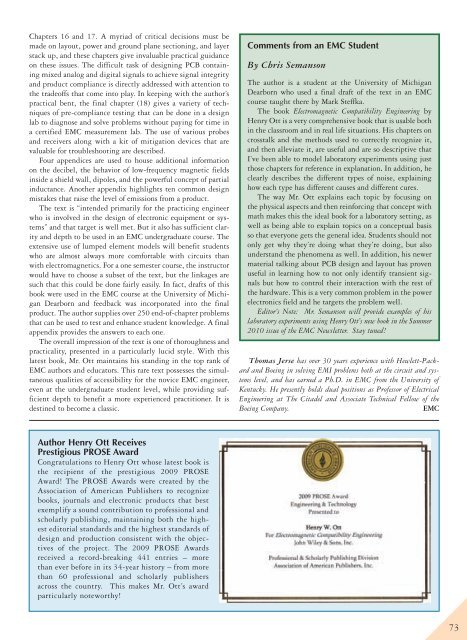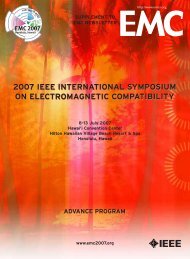Tutorial: EMC & Signal Integrity using SPICE, page 44 - IEEE EMC ...
Tutorial: EMC & Signal Integrity using SPICE, page 44 - IEEE EMC ...
Tutorial: EMC & Signal Integrity using SPICE, page 44 - IEEE EMC ...
Create successful ePaper yourself
Turn your PDF publications into a flip-book with our unique Google optimized e-Paper software.
Chapters 16 and 17. A myriad of critical decisions must be<br />
made on layout, power and ground plane sectioning, and layer<br />
stack up, and these chapters give invaluable practical guidance<br />
on these issues. The difficult task of designing PCB containing<br />
mixed analog and digital signals to achieve signal integrity<br />
and product compliance is directly addressed with attention to<br />
the tradeoffs that come into play. In keeping with the author’s<br />
practical bent, the final chapter (18) gives a variety of techniques<br />
of pre-compliance testing that can be done in a design<br />
lab to diagnose and solve problems without paying for time in<br />
a certified <strong>EMC</strong> measurement lab. The use of various probes<br />
and receivers along with a kit of mitigation devices that are<br />
valuable for troubleshooting are described.<br />
Four appendices are used to house additional information<br />
on the decibel, the behavior of low-frequency magnetic fields<br />
inside a shield wall, dipoles, and the powerful concept of partial<br />
inductance. Another appendix highlights ten common design<br />
mistakes that raise the level of emissions from a product.<br />
The text is “intended primarily for the practicing engineer<br />
who is involved in the design of electronic equipment or systems”<br />
and that target is well met. But it also has sufficient clarity<br />
and depth to be used in an <strong>EMC</strong> undergraduate course. The<br />
extensive use of lumped element models will benefit students<br />
who are almost always more comfortable with circuits than<br />
with electromagnetics. For a one semester course, the instructor<br />
would have to choose a subset of the text, but the linkages are<br />
such that this could be done fairly easily. In fact, drafts of this<br />
book were used in the <strong>EMC</strong> course at the University of Michigan<br />
Dearborn and feedback was incorporated into the final<br />
product. The author supplies over 250 end-of-chapter problems<br />
that can be used to test and enhance student knowledge. A final<br />
appendix provides the answers to each one.<br />
The overall impression of the text is one of thoroughness and<br />
practicality, presented in a particularly lucid style. With this<br />
latest book, Mr. Ott maintains his standing in the top rank of<br />
<strong>EMC</strong> authors and educators. This rare text possesses the simultaneous<br />
qualities of accessibility for the novice <strong>EMC</strong> engineer,<br />
even at the undergraduate student level, while providing sufficient<br />
depth to benefit a more experienced practitioner. It is<br />
destined to become a classic.<br />
Author Henry Ott Receives<br />
Prestigious PROSE Award<br />
Congratulations to Henry Ott whose latest book is<br />
the recipient of the prestigious 2009 PROSE<br />
Award! The PROSE Awards were created by the<br />
Association of American Publishers to recognize<br />
books, journals and electronic products that best<br />
exemplify a sound contribution to professional and<br />
scholarly publishing, maintaining both the highest<br />
editorial standards and the highest standards of<br />
design and production consistent with the objectives<br />
of the project. The 2009 PROSE Awards<br />
received a record-breaking <strong>44</strong>1 entries – more<br />
than ever before in its 34-year history – from more<br />
than 60 professional and scholarly publishers<br />
across the country. This makes Mr. Ott’s award<br />
particularly noteworthy!<br />
Comments from an <strong>EMC</strong> Student<br />
By Chris Semanson<br />
The author is a student at the University of Michigan<br />
Dearborn who used a final draft of the text in an <strong>EMC</strong><br />
course taught there by Mark Steffka.<br />
The book Electromagnetic Compatibility Engineering by<br />
Henry Ott is a very comprehensive book that is usable both<br />
in the classroom and in real life situations. His chapters on<br />
crosstalk and the methods used to correctly recognize it,<br />
and then alleviate it, are useful and are so descriptive that<br />
I’ve been able to model laboratory experiments <strong>using</strong> just<br />
those chapters for reference in explanation. In addition, he<br />
clearly describes the different types of noise, explaining<br />
how each type has different causes and different cures.<br />
The way Mr. Ott explains each topic by foc<strong>using</strong> on<br />
the physical aspects and then reinforcing that concept with<br />
math makes this the ideal book for a laboratory setting, as<br />
well as being able to explain topics on a conceptual basis<br />
so that everyone gets the general idea. Students should not<br />
only get why they’re doing what they’re doing, but also<br />
understand the phenomena as well. In addition, his newer<br />
material talking about PCB design and layout has proven<br />
useful in learning how to not only identify transient signals<br />
but how to control their interaction with the rest of<br />
the hardware. This is a very common problem in the power<br />
electronics field and he targets the problem well.<br />
Editor’s Note: Mr. Semanson will provide examples of his<br />
laboratory experiments <strong>using</strong> Henry Ott’s new book in the Summer<br />
2010 issue of the <strong>EMC</strong> Newsletter. Stay tuned!<br />
Thomas Jerse has over 30 years experience with Hewlett-Packard<br />
and Boeing in solving EMI problems both at the circuit and systems<br />
level, and has earned a Ph.D. in <strong>EMC</strong> from the University of<br />
Kentucky. He presently holds dual positions as Professor of Electrical<br />
Engineering at The Citadel and Associate Technical Fellow of the<br />
Boeing Company. <strong>EMC</strong><br />
73

















